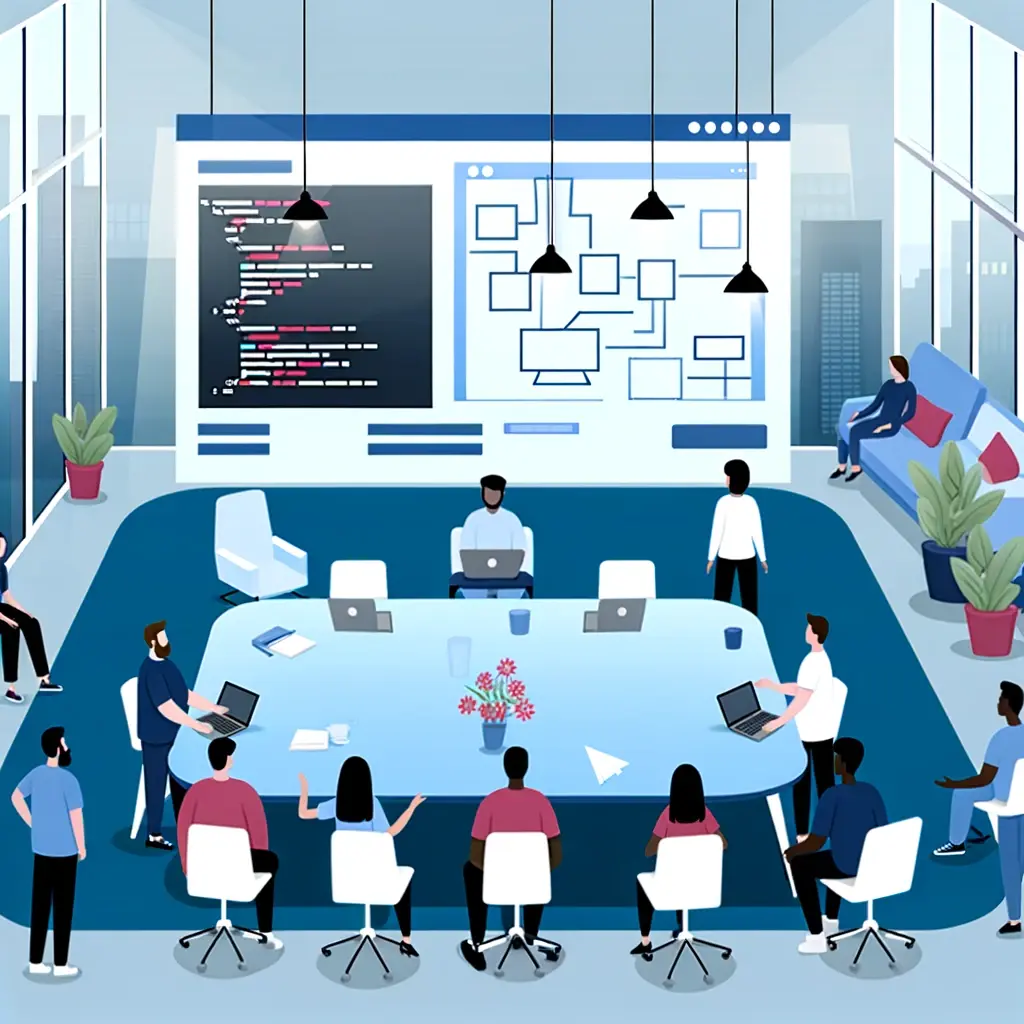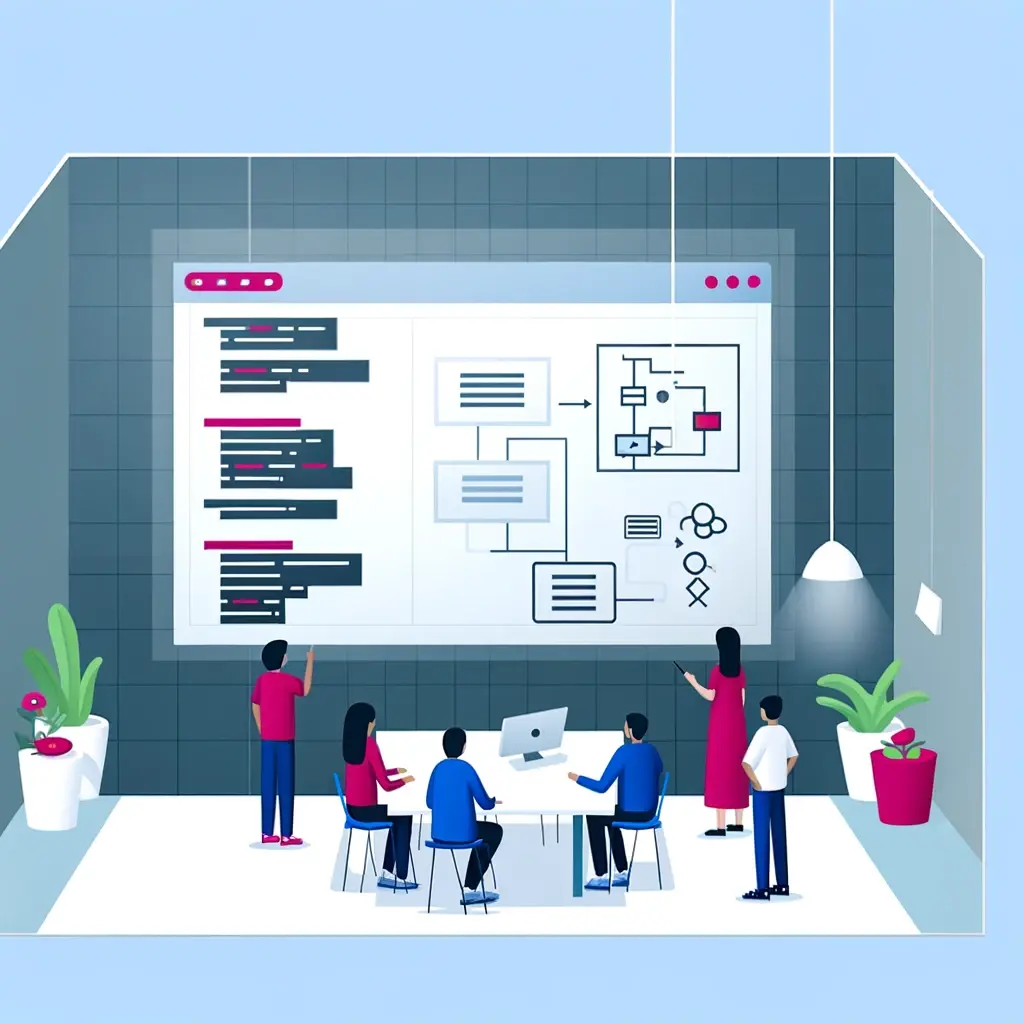- Home
- -Blog
Development Team Extension: Future of Tech Growth

- 13 Feb 2024
- Admin
Development Team Extension: Maximizing Your Tech Potential
As software projects grow in scope and complexity, development teams often find themselves needing additional talent and bandwidth. At times, the core in-house team lacks certain skill sets that are needed to take the product or project to the next level. Other times, the team simply has too much on their plate and needs reinforcements to maintain velocity.
Whatever the reason, most development shops eventually face the decision of whether to extend their team by bringing on additional staff members or contractors. Extending an engineering team can be tricky if not done carefully. But it also represents a major opportunity to accelerate innovation for organizations that get it right.
With the digital transformation accelerating across industries, the demand for tech talent has skyrocketed. According to a report by McKinsey, 87% of organizations globally are aware of the talent gaps within their companies but find it challenging to fill these gaps due to the competitive nature of the tech talent market.
Development team extension serves as a strategic solution to this challenge, providing a flexible and cost-effective way to access the required skills without the long-term commitments and overheads associated with traditional hiring processes.
Whether you're a startup looking to rapidly prototype a new product or a large enterprise aiming to accelerate your digital transformation, understanding how to effectively integrate external talent into your projects is key.
Read on to learn some tips and frameworks as you scale your software squad!
Understanding Team Extension
Team extension is a dynamic approach designed to bolster your existing development team with additional talent, addressing specific needs that your in-house team may lack or providing extra manpower to accelerate project timelines. In many cases, this can also involve specialized DevOps recruitment to strengthen infrastructure, automation, and deployment capabilities that keep projects running efficiently. Unlike traditional hiring, which focuses on long-term employment within the company, team extension is more about enhancing your current team's capabilities on an as-needed basis. This model stands out from outsourcing and dedicated development teams in several key ways.
How It Works and Differentiation
- Team Extension: You add external professionals to work alongside your in-house team, integrating them into your existing workflows and projects. They are considered an extension of your team, albeit not permanent employees.
- Outsourcing: This involves handing over entire projects or specific tasks to an external company. The outsourcing partner manages the project independently, with minimal direct oversight from the client.
- Dedicated Development Teams: A dedicated team is a group of professionals provided by a vendor but exclusively focused on your projects, acting as a remote but integral part of your organization. Unlike team extension, this model often implies a longer-term engagement and can involve managing an entire project or function.
- Flexibility: Team extension offers unparalleled flexibility, enabling companies to scale their teams up or down based on current project demands and timelines. This approach is also highly effective when managing IT hardware lifecycle processes, as it allows businesses to integrate specialized talent to address specific hardware management needs during peak project phases. This adaptability is crucial in today's fast-paced market, where needs can change rapidly.
- Access to Niche Skills: With the tech landscape evolving at breakneck speed, keeping up with the latest technologies can be daunting. Team extension allows you to bring in specialists with the exact skill sets needed for specific projects or to fill gaps in your team's expertise, ensuring you're always at the forefront of innovation.
- Scalability: Whether you're dealing with unexpected project scope changes or need to accelerate your development process, team extension enables you to scale your workforce quickly and efficiently. This means you can adapt to market demands without the overheads associated with permanent hires.
- Loyalty: Although external, extended team members can develop a sense of loyalty and commitment to your projects, especially when they're integrated into your teams over longer periods. This loyalty can enhance project continuity and quality, as these team members become deeply familiar with your company's goals, culture, and processes.
In essence, team extension is a strategic approach that combines the best aspects of in-house development and external hiring, offering a balanced solution for companies looking to stay agile and competitive in the digital age. It provides a way to access top talent and cutting-edge skills on demand, ensuring your projects are always powered by the best the industry has to offer.
Strategic Implementation
Successfully integrating extended team members into your existing setup requires careful planning and strategic execution.

Steps to Effectively Integrate Extended Team Members
- Onboarding and Orientation: Start with a comprehensive onboarding process. This should include introductions to in-house team members, an overview of company culture, and a deep dive into ongoing projects. The goal is to make extended team members feel part of the team from day one.
- Define Roles and Expectations: Clearly outline the roles, responsibilities, and expectations for each team member. This clarity helps in minimizing confusion and aligning everyone towards common project goals.
- Use Common Tools and Platforms: Ensure that both your in-house and extended team members use the same communication, project management, and development tools. This uniformity fosters a cohesive working environment, regardless of geographical locations.
- Regular Check-ins and Feedback Sessions: Schedule regular meetings for progress updates, feedback, and addressing any concerns. This continuous dialogue is vital for maintaining alignment and addressing issues proactively.
- Cultural Sensitivity Training: If your extended team comes from a different cultural background, provide cultural sensitivity training to your entire team. Understanding and respecting cultural differences enhance team cohesion and collaboration.
Communication Strategies for Seamless Collaboration
- Leverage Technology for Real-Time Communication: Use communication tools like Slack, Zoom, or Microsoft Teams to facilitate real-time conversations. These platforms help bridge the gap caused by different locations and time zones.
- Set Overlapping Hours: Identify and set specific hours during which team members from different time zones can work together. This overlap is crucial for real-time collaboration, team meetings, and decision-making processes.
- Asynchronous Communication: For non-urgent matters, adopt asynchronous communication methods, allowing team members to contribute according to their own time zones without feeling left out or pressured to respond immediately.
- Clear Documentation: Maintain comprehensive documentation of meetings, decisions, and project updates. This ensures that all team members, regardless of when they work, have access to the latest information.
By implementing these strategies, you can ensure a smooth and effective integration of extended team members into your projects, leading to a more productive and harmonious working environment. Remember, the key to successful team extension lies in clear communication, mutual respect, and a shared commitment to project goals.
Choosing the Right Model for Team Extension
When it comes to expanding your development capabilities, selecting the right team extension model is crucial. Each model—outstaffing, outsourcing, IT staff augmentation, and dedicated development teams—has its unique set of benefits and challenges. Below, we detail each model and provide a pros and cons table for a clearer comparison.
Outstaffing
Definition: Outstaffing involves hiring remote professionals who are officially employed by a third-party provider. These individuals work exclusively on your projects, but the administrative, HR, and legal responsibilities remain with the outstaffing company.
Pros and Cons
| Pros | Cons |
|---|---|
| Direct control over the work process and team members | Requires management and integration efforts from your side |
| Cost-effective compared to hiring in-house for certain regions | Less control over company culture integration |
| Flexibility in scaling the team up or down | Potential risks related to confidentiality and data security |
Outsourcing
Definition: Outsourcing is the practice of delegating specific tasks or entire projects to an external company. This company takes full responsibility for the management and execution of the work, delivering results based on agreed-upon objectives and timelines.Pros and Cons
| Pros | Cons |
|---|---|
| Reduced operational and labor costs | Less direct control over the project's execution |
| Access to a wide range of expertise and specialized skills | Potential challenges in communication and alignment with business goals |
| Allows focus on core business activities | Risk of dependency on the outsourcing provider for critical knowledge and operations |
IT Staff Augmentation
Definition: IT staff augmentation is a flexible strategy that allows companies to add skilled technical professionals to their in-house team on an as-needed basis. This model is designed to address the specific skill gaps within a project or team without the long-term commitment of hiring new full-time employees.Pros and Cons
| Pros | Cons |
|---|---|
| High level of control and integration with in-house teams | Can create dependency on external talents for critical skills |
| Flexibility to quickly adapt to project needs and market changes | Potential for higher costs compared to other models, depending on the market rates of augmented staff |
| Seamless collaboration and communication | Challenges in managing a blended team of in-house and augmented staff |
Dedicated Development Teams
Definition: A dedicated development team is a long-term collaboration model where an external provider forms a team of professionals who work exclusively on your projects. This team acts as an extension of your in-house staff, closely aligning with your company's processes and culture.Pros and Cons
| Pros | Cons |
|---|---|
| Full integration into your company's culture and processes | Requires time and effort for initial setup and integration |
| Long-term collaboration fosters deep understanding of project objectives | Higher commitment can lead to less flexibility compared to other models |
| Cost-effective for ongoing, large-scale projects | Potential challenges in scaling down quickly if project needs decrease |
Cost Considerations and Optimization
When it comes to extending your development team, understanding and managing costs is crucial for ensuring your project stays within budget while still achieving your desired outcomes. The cost of team extension services can vary widely based on several factors, including the model chosen, the skill level of the professionals required, the project's complexity, and the geographical location of the team members. Here's a closer look at these factors and strategies for optimizing your budget.
Factors Influencing Cost
- Model of Team Extension: Different models come with varying price tags. For instance, outsourcing might be more cost-effective for short-term projects, while dedicated development teams could offer better value for long-term engagements.
- Skill Level and Expertise: Highly specialized skills or expertise in cutting-edge technologies can command higher rates. The more niche the technology, the higher the cost is likely to be.
- Project Complexity: Complex projects requiring advanced problem-solving, extensive development, and additional management will incur higher costs due to the increased workload and expertise required.
- Geographical Location: Labor costs vary significantly across different regions. Developers from North America and Western Europe tend to have higher rates compared to those from Eastern Europe, Asia, or Latin America.
Strategies for Budget Optimization
- Clearly Define Project Scope and Requirements: Avoid scope creep by having a clear, detailed project plan. Utilizing cost estimating software can help streamline this process by providing accurate projections based on the project's parameters, reducing the likelihood of unexpected expenses.
- Choose the Right Model Based on Needs: Evaluate the pros and cons of each team extension model in the context of your specific project needs and budget constraints. For example, staff augmentation can be ideal for short-term, specialized needs, whereas a dedicated team might be more cost-effective for ongoing development work.
- Leverage Global Talent Pools: Consider hiring professionals from regions with lower labor costs. Countries like Ukraine, Poland, India, and others in Eastern Europe and Asia offer a rich talent pool with competitive rates.
- Prioritize Effective Communication: Miscommunications can lead to costly mistakes. Investing in robust communication tools and practices can save money in the long run by ensuring that everyone is aligned with the project goals and progress.
- Continuous Monitoring and Adjustment: Regularly review the project's progress and expenses. This proactive approach allows for timely adjustments to stay on budget.
Comparison of Costs Across Different Regions
The cost of hiring development talent varies significantly around the globe. For instance:
- Asia: Regions like India, the Philippines, and Vietnam are known for their competitive pricing structures, making them attractive for businesses looking to optimize costs.
- North America: Rates are generally higher, with the United States and Canada offering top-tier talent at premium rates.
- Western Europe: Countries like Germany, the UK, and France also command higher rates due to the high cost of living and strong economies.
- Eastern Europe: Offers a compelling mix of quality and cost-efficiency, with countries like Ukraine, Poland, and Romania becoming popular destinations for team extension.
By understanding these factors and strategically planning your team extension, you can achieve an optimal balance between cost and quality, ensuring that you get the best value for your investment in expanding your development capabilities.
The Future of Team Extension
As we look towards the future, several emerging trends are set to shape the way businesses approach team extension, leveraging new technologies and methodologies to optimize collaboration, productivity, and project outcomes.
Emerging Trends Shaping Team Extension
- Remote Work as the New Norm: The future of team extension will be heavily influenced by the normalization of remote work. The COVID-19 pandemic accelerated this shift, demonstrating that teams could remain productive and collaborative regardless of geographical distances. This trend is likely to continue, expanding the talent pool for team extension beyond regional constraints and facilitating global collaboration.
- Increased Use of Collaboration Tools: As remote work becomes more prevalent, the use of digital collaboration tools is set to increase. Tools that support real-time communication, project management, and development workflows are becoming more sophisticated, enabling distributed teams to work together more efficiently and effectively.
- Hybrid Models of Team Extension: Businesses are exploring hybrid models that combine the benefits of various team extension approaches. For example, combining staff augmentation with dedicated teams to balance flexibility and commitment, or blending in-house and remote work to optimize productivity and employee satisfaction. Recognizing and rewarding employees' efforts is essential to maintaining morale and motivation; businesses should also take the opportunity to personalized awards trophies, fostering a stronger connection to the organization.Consistent appreciation can be streamlined through employee recognition software, helping hybrid teams stay connected and acknowledged no matter where they work from.
- Specialization and Niche Skills Demand: As technology continues to advance, there's a growing demand for professionals with specialized skills, particularly in emerging fields like artificial intelligence (AI), machine learning (ML), blockchain, and cybersecurity. This trend is pushing businesses to adopt team extension strategies to access these niche skills quickly.

The Role of AI and Machine Learning in Optimizing Team Extension Strategies
AI and ML are not just areas of specialization within team extension; they're also tools that can significantly enhance team extension strategies themselves.
- Talent Matching and Recruitment: AI-driven platforms can streamline the process of finding and matching the right talent to specific project needs. By analyzing vast amounts of data on candidates' skills, experience, and even cultural fit, these platforms can make the recruitment process faster and more accurate.
- Project Management and Productivity: AI and ML tools can help manage projects more efficiently by predicting potential bottlenecks, optimizing resource allocation, and even automating routine tasks. This can free up team members to focus on more complex, high-value work.
- Enhanced Communication and Collaboration: AI can facilitate better communication among distributed teams by providing real-time language translation, sentiment analysis to gauge team morale, and even suggesting optimal times for meetings across different time zones.
- Continuous Learning and Skill Development: AI-powered learning platforms can provide personalized learning experiences for team members, helping them to upskill or reskill as project demands evolve. This ensures that the extended team remains on the cutting edge of technology trends.
As we move forward, the integration of AI and ML into team extension strategies will become increasingly sophisticated, driving efficiencies, enhancing collaboration, and ensuring that teams have the skills they need to tackle future challenges. The companies that can effectively leverage these trends and technologies will be well-positioned to thrive in the evolving landscape of team extension.
Conclusion
Team extension, when executed thoughtfully, provides a powerful lever for businesses to access specialized skills, embrace flexibility, and drive innovation, all while optimizing costs. The evolution of remote work, the integration of advanced technologies like AI and ML, and the emphasis on cultural fit and collaboration underscore the shift towards a more agile and interconnected global workforce.
As businesses continue to navigate the rapidly changing technological landscape, the strategic adoption of team extension models will play a crucial role in staying competitive. By carefully selecting the right model, embracing emerging trends, and leveraging technology to optimize strategies, companies can build resilient, innovative, and high-performing teams capable of turning challenges into opportunities.



